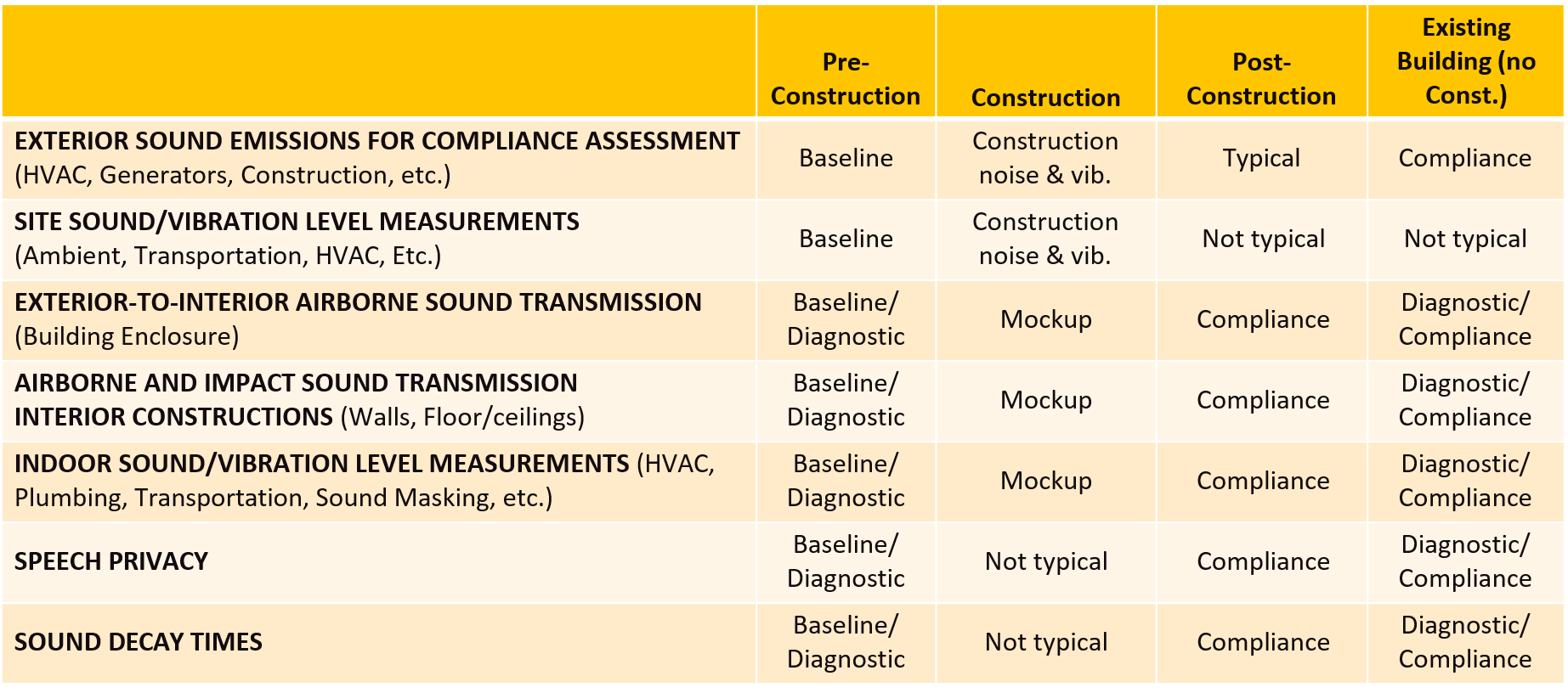Sound Isolation and Privacy
30 Mar 2021
Acoustical Field Measurements & Testing
Field testing can be beneficial for assessing acoustical conditions in buildings for a variety of construction needs, such as documenting baseline conditions, assessing isolation performance, or evaluating final installed conditions for compliance with codes or regulations. It can be beneficial in the pre-construction, construction, or post-construction stages, or on existing buildings.
Four factors of how our perception of sound privacy is influenced by various conditions, whether residential or other building types: source volume, construction isolation, background sound, and personal sensitivity. Depending on the specific needs of a building or project, these sound privacy concerns can be assessed with various types of field measurement and testing, such as:
- Exterior sound emissions for compliance: Assesses the project's sound emissions to the surrounding environment and community. Evaluations are conducted using ASTM E1780.
- Site sound level measurements: Gages conditions of a site prior to development, documenting baseline conditions or the potential exposure to the future project.
- Site vibration level assessment: Uses ASTEM 1503 to assess sound measurements using a digital statistical sound analysis system.
- Exterior-to-Interior airborne sound transmission: Quantifies the airborne sound transmission from the exterior through the building enclosure to the interior, using ASTM E966
- Airborne sound transmission through interior constructions: Using ASTM E336 measures the airborne sound transmission from one interior space to another through a demising assembly with one or more components
- Impact sound transmission: Calculates the impact sound transmission of a floor-ceiling assembly using a tapping machine on the floor surface. This is done to ASTM E1007 and results in three possible ratings.
- Indoor sound level measurements: Quantifies sound levels within a room from interior and exterior sources. ANSI S12.72 provides the guidance for this assessment.
- Indoor vibration level measurements: Looks at vibration levels from equipment or occupant activities for assess impacts to the occupants or vibration- sensitive equipment. Results in acceleration can be compared to ANSI S2.71.
- Speech privacy: Uses ASTM E2638 to measure the speech privacy provided by a closed room and results in a speech privacy class (SPC) rating. It is considered more applicable for high privacy conditions
- Sound decay: Assesses breakdown of sound within a space using ASTM E2235.
Acoustical field measurements and testing can be done at various points during a building's life cycle for baseline, diagnostic or compliance purposes, as outlined in this table.

Assessments apply to a variety of building types, including: multi-family/mixed use residential, government/defense, education, corporate/office, industrial/infrastructure, entertainment, transportation, civic/non-profits, retail/hospitality, and worship spaces. Because these settings all have different needs related to transmission, privacy, vibration, etc. the location will determine the type of testing done and the acceptable outcomes.
Acoustical testing is an important factor of building and construction projects, ensuring comfort, privacy and code compliance. Get more insights into conducting field evaluations for acoustical testing, including details on how the tests are performed in our webinar recording.

Jeffrey Fullerton,
Department Manager, Building Science Solutions
Jeff Fullerton has more than 20 years of experience providing acoustical consulting guidance to clients. His past projects include mixed use facilities, entertainment venues, corporate and commercial buildings, single and multi-family residences, higher education buildings, government facilities, transportation terminals, healthcare facilities, and industrial plants. He holds degrees in mechanical engineering, holds several related professional certifications, and is a Fellow with the Institute for Noise Control Engineering.

Dan Johnson,
Department Manager, Building & Construction
Dan Johnson is responsible for the lab and field testing services of Intertek's Minnesota laboratory and field testing staff, which includes air/water structural/windstorm testing, thermal simulations, insulated glass, acoustical, windows/doors, facades and failure investigations. He has more than 30 years of laboratory and field experience in the evaluation of fenestration product performance and field testing, inspection, and documentation of various construction projects.